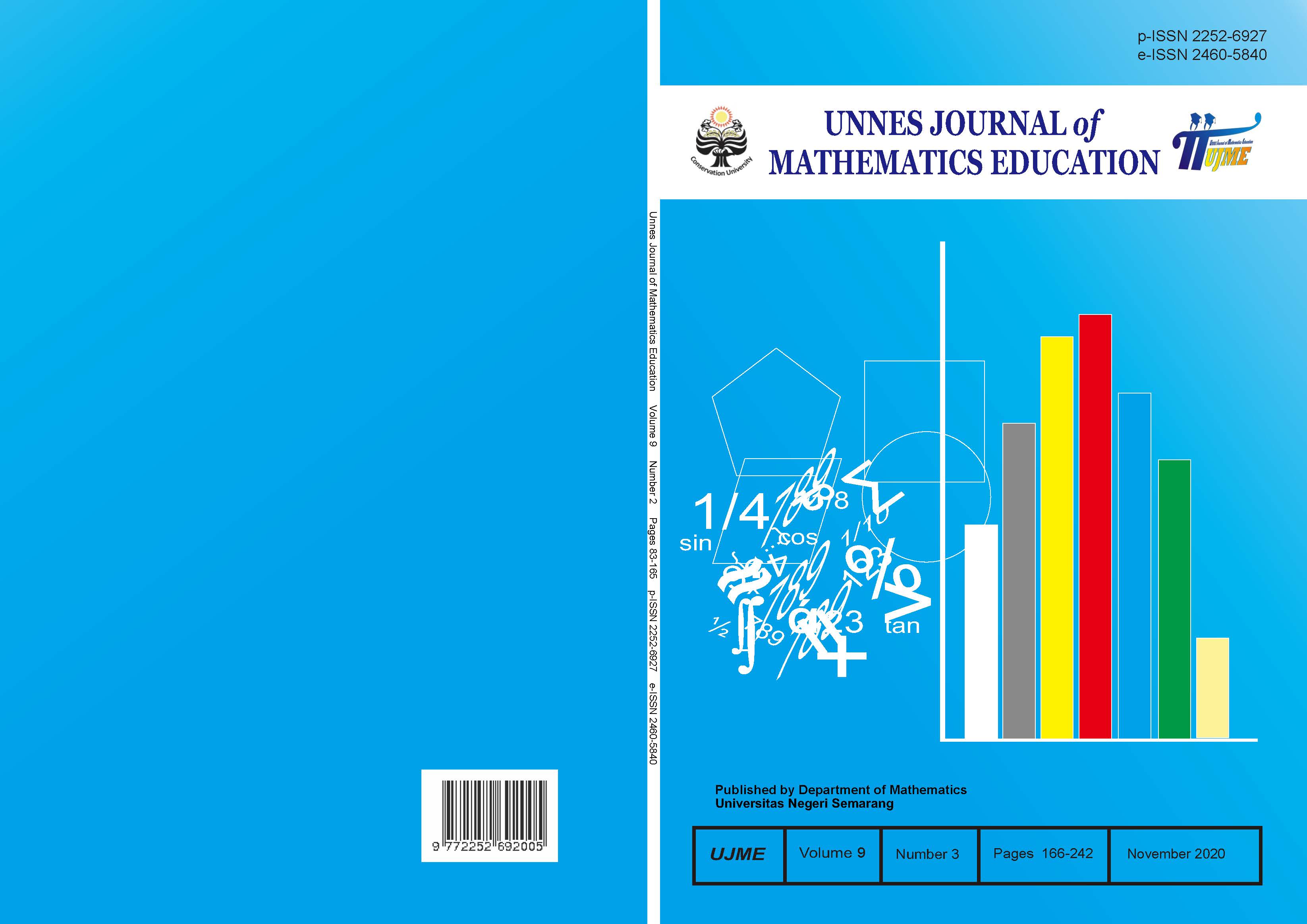The application of fast feedback in discovery learning on the achievement of critical thinking ability reviewed from adversity quotient
##plugins.themes.academic_pro.article.main##
Abstract
The objectives of this research were (1) to discover the effectiveness of discovery learning model with fast feedback towards the students’ achievement of critical thinking abilities; and (2) to describe students' critical thinking abilities reviewed from adversity quotient. The research method and design used in this research was mix methods with sequential explanatory. The population of this research were 7th grade students of Junior High School 1 Semarang. Sampling for the experiment class and control class by means of cluster random sampling, and the selection of subjects using purposive sampling technique. The results showed that discovery learning with fast feedback was effective in achieving students' critical thinking abilities. The description of the subject's critical thinking abilities based on the adversity quotient showed that: (1) the climbers’ subjects could master four indicators of critical thinking, namely interpretation, analysis, inference, and evaluation; (2) the campers-climbers’ subjects could master two indicators of critical thinking, namely analysis and inference, and sufficiently master the indicators of interpretation and evaluation; and (3) the campers’ subjects has sufficiently master two indicators of critical thinking, namely infer
##plugins.themes.academic_pro.article.details##
References
Arifin, M., Kartono, & Mariani, S. (2020). Efektivitas Quick and Quient feedback dalam pembelajaran model Discovery Learning pada pencapaian pemecahan masalah matematissiswa. PRISMA, Proceeding National Seminar of Matematics, 3, 330-334.
Brookfield, S. D. (2012). Teaching for Critical Thinking: Tools and Techniques to Help Students Question Their Assumptions. San Francisco: Jossey-Bass.
Chen, J. C., Whittinghil, D. C., & Kadlowec, J. A. (2010). Classes That Click: Fast, Rich Feedback to Enhance Student Learning and Satisfaction. Journal of Engineering Education, 99(2), 159-168.
Dann, R. (2019). Feedback as a Relational Concept in The Classroom. The Curriculum Journal, 30(4), 352-374.
Darojat, L., & Kartono. (2016). Kemampuan Pemecahan Masalah Siswa dalam Menyelesaikan Soal Open Ended Berdasarkan AQ dengan Learning Cycle 7E. Unnes Journal of Mathematics Education Research, 5(1), 1-8.
Ennis, R. H. (2011). The Nature of Critical Thinking: An Outline of Critical Thinking Dispositions and Abilities. In Sixth International Conference on Thinking at MIT. Cambridge.
Facione, P. A. (2015). Critical Thinking: What It Is and Why It Counts. Millbrae: California Academic Press.
Fauziah, I. N. L., Usodo, B., & Ch, H. E. (2013). Proses Berpikir Kreatif Siswa kelas X dalam Memecahkan Masalah Geometi Berdasarkan Tahapan Wallas Ditinjau dari Adversity Quotient (AQ) Siswa. Jurnal Pendidikan Matematika Solusi, 1(1), 1-16.
Haeruman, L. D., Rahayu, W., & Ambarwati, L. (2017). Pengaruh Discovery Learning terhadap Peningkatan Kemampuan Berpikir Kritis Matematis dan Self-Confidence Ditinjau dari Kemampuan Awal Matematis Siswa SMA di Bogor Timur. JPPM, 10(2), 157-168.
Haris, F., Riyanto, Y., & Fatmawati, U. (2015). Pengaruh Model Guided Discovery Learning Terhadap Kemampuan Berpikir Kritis Siswa Kelas X SMA Negeri Karangpandan Tahun Pelajaran 2013/2014. Jurnal Pendidikan Biologi. 7(2), 114-122.
Hidayat, W., & Sari, V. T. A. (2019). Kemampuan Berpikir Kritis Matematis dan Adversity Quotient Siswa SMP. Jurnal Elemen, 5(2), 242-252.
Ismah, & Sundi, V. H. (2018). Penerapan Model Discovery Learning untuk meningkatkan Hasil Belajar Matematika Siswa Keas VII SMP Labschool FIPUMJ. FIBONACCI: Jurnal Pendidikan Matematika dan Matematika, 4(2), 161-169.
Leonard, & Amanah, N. (2014). Pengaruh Adversity Quotient (AQ) Dan Kemampuan Berpikir Kritis Terhadap Prestasi Belajar Matematika. Perspektif Ilmu Pendidikan, 28(1), 55-64.
Masrukan. (2014). Asesmen Otentik Pembelajaran Matematika. Semarang: FMIPA Unnes.
Mukarromah, A., & Sartono, E. K. E. (2018). Analisis Kemampuan Berpikir Kritis pada Model Discovery Learning Berdasarkan Pembelajaran Tematik. Indonesian Journal of Primary Education, 2(1), 38-47.
Nafi’an, M. I. (2016). Analisis Berpikir Konseptual, Semikonseptual, dan Komputasional Siswa SD dalam Menyelesaikan Soal Cerita. Jurnal Pendidikan dan Pembelajaran Matematika. 2(2), 72-78.
Naimnule, M., Kartono, & Asikin, M. (2020). Mathematics Problem Solving Ability in Terms of Adversity Quotient in Problem Based Learning Model With Peer Feedback. Unnes Journal of Mathematics Education Research, 10(2), 222-228.
NCTM. (2000). Principles and Standards for School Mathematics. USA: NCTM.
Nurrohmi, Y., Utaya, S., & Utomo, D. H. (2017). Pengaruh Model Pembelajaran Discovery Learning terhadap Kemampuan Berpikir Kritis Mahasiswa. Jurnal Pendidikan : Teori, Penelitian, dan Pengembangan, 2(10), 1308-1314.
Peraturan Menteri Pendidikan Nasional Nomor 22 Tahun 2006 Tentang Tujuan Pendidikan (Decree of The Indonesian Minister of Education Number 22, 2006)
Perkins, C. & E. Murphy. (2006). Identifying and Measuring Individual Engagement in Critical Thinking in online Discussion An Exploratory
Case Study. Educational Technology & Society, 9(1), 298-307.
Pratiwi, F. A. (2014). Pengaruh Penggunaan Model Discovery Learning dengan Pendekatan Saintifik terhadap Keterampilan Berpikir Kritis SMA. Jurnal Pendidikan dan Pembelajaran Khatulistiwa, 3(7), 1-16.
Sabiila, A., Waluya, S.B., & Junaedi, I. (2019). Kreativitas Matematis Siswa Kelas VIII Ditinjau dari Adversity Quotient dalam Setting PBL dengan Pendekatan RME pada Materi SPLDV. Unnes Journal of Mathematics Education, 7(2), 910-921.
Seventika, S. Y., Sukestiyarno, Y. L., & Mariani, S. (2018). Critical Thinking Analysis Based on Facione (2015) – Angelo (1995) Logical Mathematics Material of Vocational High School (VHS). Journal of Physics: Conference Series, 983, 1-6.
Stoltz, P. G. (2007). Adversity Quotient Mengubah Hambatan menjadi Peluang. Jakarta: PT Grasindo.
Sudarman. (2012). Adversity Quotient: Kajian Kemungkinan Pengintegrasinya dalam Pembelajaran Matematika. Jurnal AKSIOMA, 1(1), 55-62.
Sugiyono. (2016). Metode Penelitian Kuantitatif, Kualitatif, dan R&D. Bandung: Alfabeta.
Sulistiani, E., & Masrukan. (2015). Pentingnya Berpikir Kritis dalam Pembelajaran Matematika untuk Menghadapi Tantangan MEA. PRISMA, Proceeding National Seminar of Matematics, 605-612.
Syah. (2004). Psikologi Pendidikan dengan Pendekatan Baru. Bandung: PT Remaja Rosdakarya.
Wulandari, I. P. (2019). Berpikir Kritis Matematis dan Kepercayaan Diri Siswa Ditinjau dari Adversity Quotient (Matematical Critical Thinking and Student Confidence Reviewed from Adversity Quotient). (MaSter’s Thesis). Universitas Negeri Semarang. Semarang.
Yanti, A. P. & Syazali, M. (2016). Analisis Proses Berpikir Siswa dalam Memecahkan masalah matematika berdasarkan langkah-langkah Bransford dan Stein ditinjau dari Adversity Quotient. Al-Jabar: Jurnal Pendidikan Matematika, 7(1), 63-74.
